Financial Decision-Making Report: Analysis of SKANSKA PLC Financials
VerifiedAdded on 2022/11/30
|10
|3028
|184
Report
AI Summary
This report provides a detailed analysis of financial decision-making, focusing on SKANSKA PLC. It begins with an introduction highlighting the importance of financial decisions for a company's long-term success. Task 1 identifies and evaluates the crucial functions, roles, and duties of accounting and finance departments within SKANSKA PLC. It examines the roles of accountants and finance managers, their duties, and responsibilities. Task 2 delves into the financial facts and figures of the company, interpreting key financial ratios such as Return on Capital Employed (ROCE), Net Profit Margin, Current Ratio, and Debtor's Collection Period. The report analyzes the company's performance based on these ratios, providing calculations and interpretations for the years 2018 and 2019. The analysis includes an evaluation of the company's strengths and weaknesses based on the financial data. The report concludes with an overall assessment of SKANSKA PLC's financial position and offers insights into potential areas for improvement. The report highlights the importance of financial statements in making informed business decisions and maintaining a competitive edge in the market.

Financial decision
making
making
Paraphrase This Document
Need a fresh take? Get an instant paraphrase of this document with our AI Paraphraser
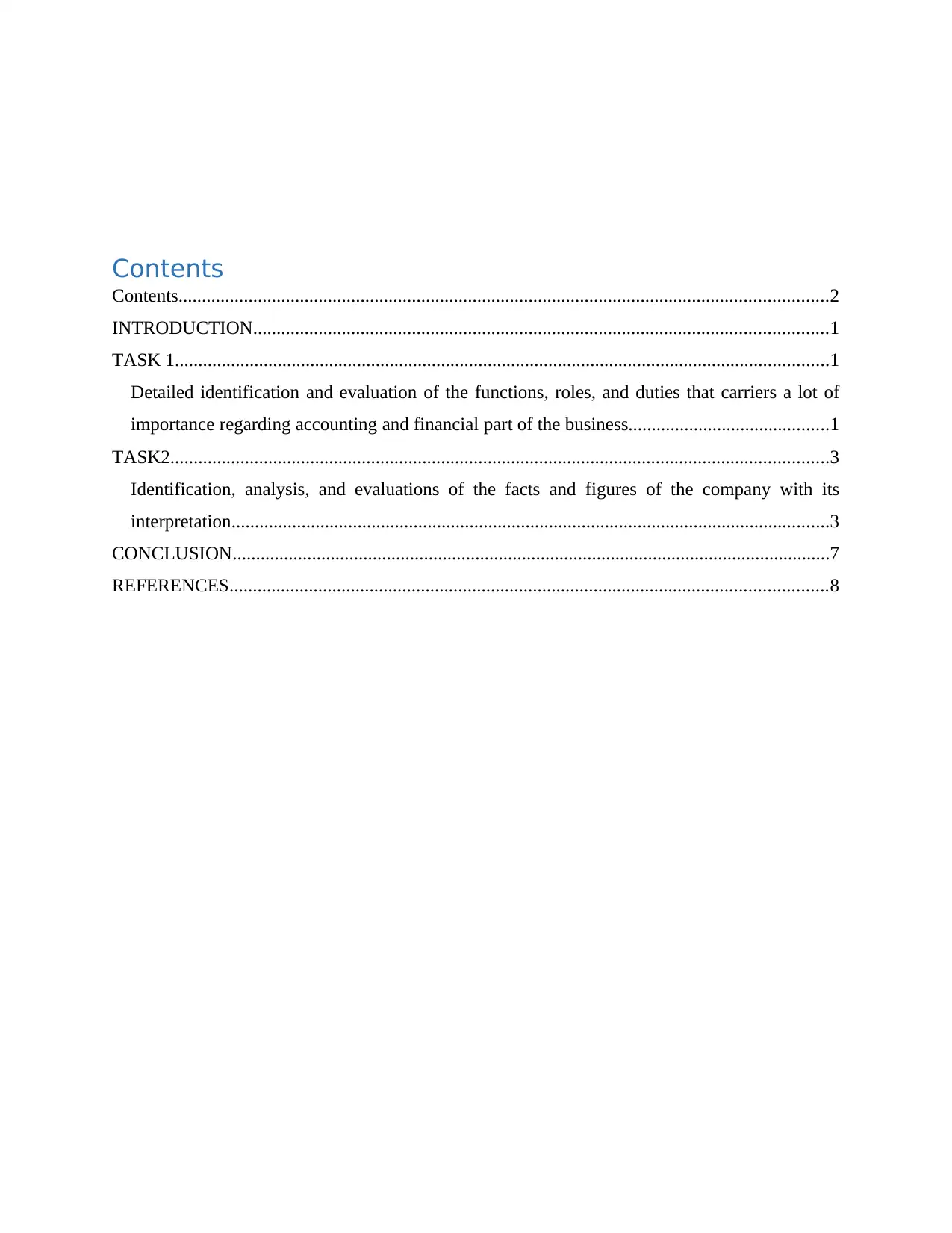
Contents
Contents...........................................................................................................................................2
INTRODUCTION...........................................................................................................................1
TASK 1............................................................................................................................................1
Detailed identification and evaluation of the functions, roles, and duties that carriers a lot of
importance regarding accounting and financial part of the business...........................................1
TASK2.............................................................................................................................................3
Identification, analysis, and evaluations of the facts and figures of the company with its
interpretation................................................................................................................................3
CONCLUSION................................................................................................................................7
REFERENCES................................................................................................................................8
Contents...........................................................................................................................................2
INTRODUCTION...........................................................................................................................1
TASK 1............................................................................................................................................1
Detailed identification and evaluation of the functions, roles, and duties that carriers a lot of
importance regarding accounting and financial part of the business...........................................1
TASK2.............................................................................................................................................3
Identification, analysis, and evaluations of the facts and figures of the company with its
interpretation................................................................................................................................3
CONCLUSION................................................................................................................................7
REFERENCES................................................................................................................................8
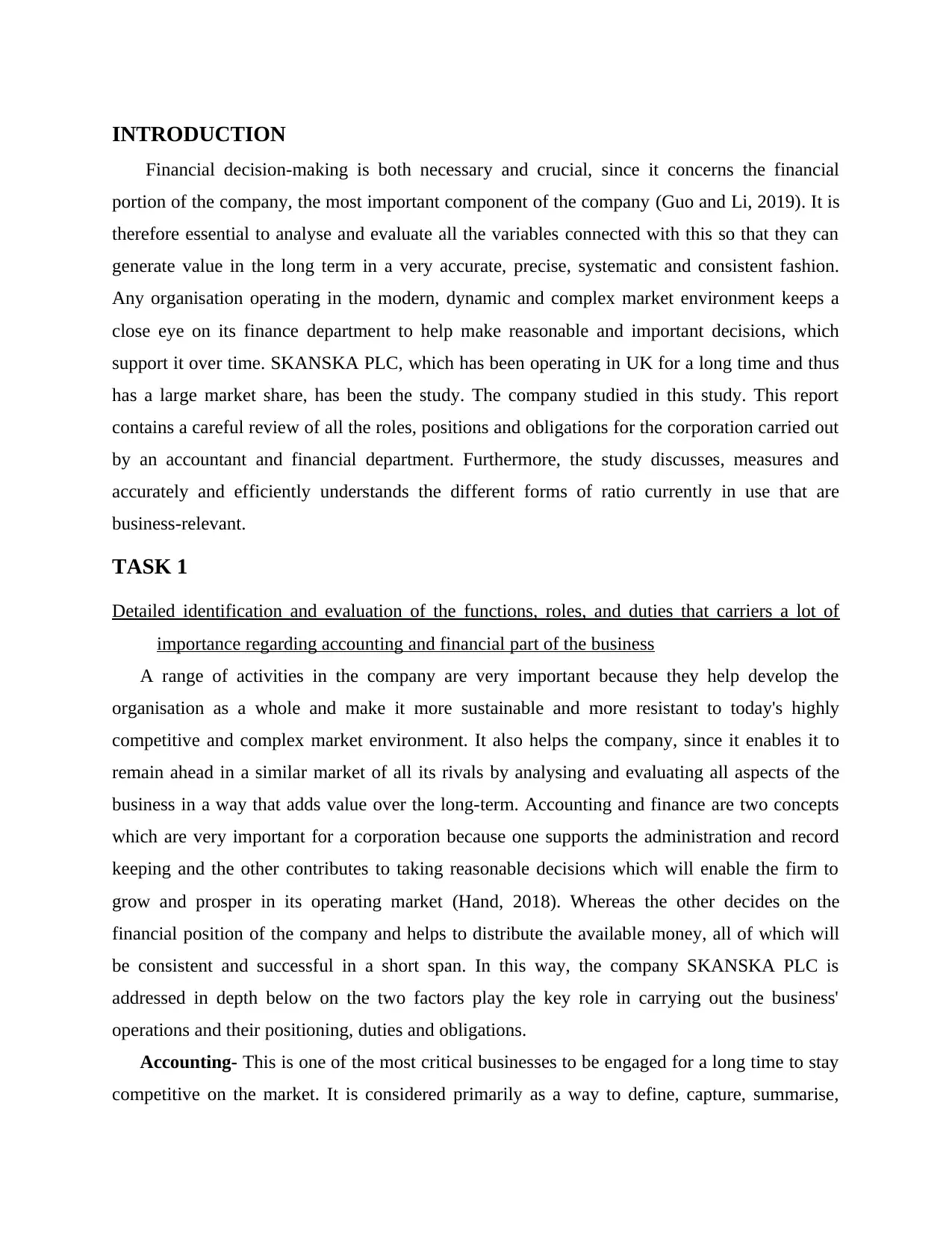
INTRODUCTION
Financial decision-making is both necessary and crucial, since it concerns the financial
portion of the company, the most important component of the company (Guo and Li, 2019). It is
therefore essential to analyse and evaluate all the variables connected with this so that they can
generate value in the long term in a very accurate, precise, systematic and consistent fashion.
Any organisation operating in the modern, dynamic and complex market environment keeps a
close eye on its finance department to help make reasonable and important decisions, which
support it over time. SKANSKA PLC, which has been operating in UK for a long time and thus
has a large market share, has been the study. The company studied in this study. This report
contains a careful review of all the roles, positions and obligations for the corporation carried out
by an accountant and financial department. Furthermore, the study discusses, measures and
accurately and efficiently understands the different forms of ratio currently in use that are
business-relevant.
TASK 1
Detailed identification and evaluation of the functions, roles, and duties that carriers a lot of
importance regarding accounting and financial part of the business
A range of activities in the company are very important because they help develop the
organisation as a whole and make it more sustainable and more resistant to today's highly
competitive and complex market environment. It also helps the company, since it enables it to
remain ahead in a similar market of all its rivals by analysing and evaluating all aspects of the
business in a way that adds value over the long-term. Accounting and finance are two concepts
which are very important for a corporation because one supports the administration and record
keeping and the other contributes to taking reasonable decisions which will enable the firm to
grow and prosper in its operating market (Hand, 2018). Whereas the other decides on the
financial position of the company and helps to distribute the available money, all of which will
be consistent and successful in a short span. In this way, the company SKANSKA PLC is
addressed in depth below on the two factors play the key role in carrying out the business'
operations and their positioning, duties and obligations.
Accounting- This is one of the most critical businesses to be engaged for a long time to stay
competitive on the market. It is considered primarily as a way to define, capture, summarise,
Financial decision-making is both necessary and crucial, since it concerns the financial
portion of the company, the most important component of the company (Guo and Li, 2019). It is
therefore essential to analyse and evaluate all the variables connected with this so that they can
generate value in the long term in a very accurate, precise, systematic and consistent fashion.
Any organisation operating in the modern, dynamic and complex market environment keeps a
close eye on its finance department to help make reasonable and important decisions, which
support it over time. SKANSKA PLC, which has been operating in UK for a long time and thus
has a large market share, has been the study. The company studied in this study. This report
contains a careful review of all the roles, positions and obligations for the corporation carried out
by an accountant and financial department. Furthermore, the study discusses, measures and
accurately and efficiently understands the different forms of ratio currently in use that are
business-relevant.
TASK 1
Detailed identification and evaluation of the functions, roles, and duties that carriers a lot of
importance regarding accounting and financial part of the business
A range of activities in the company are very important because they help develop the
organisation as a whole and make it more sustainable and more resistant to today's highly
competitive and complex market environment. It also helps the company, since it enables it to
remain ahead in a similar market of all its rivals by analysing and evaluating all aspects of the
business in a way that adds value over the long-term. Accounting and finance are two concepts
which are very important for a corporation because one supports the administration and record
keeping and the other contributes to taking reasonable decisions which will enable the firm to
grow and prosper in its operating market (Hand, 2018). Whereas the other decides on the
financial position of the company and helps to distribute the available money, all of which will
be consistent and successful in a short span. In this way, the company SKANSKA PLC is
addressed in depth below on the two factors play the key role in carrying out the business'
operations and their positioning, duties and obligations.
Accounting- This is one of the most critical businesses to be engaged for a long time to stay
competitive on the market. It is considered primarily as a way to define, capture, summarise,
⊘ This is a preview!⊘
Do you want full access?
Subscribe today to unlock all pages.

Trusted by 1+ million students worldwide
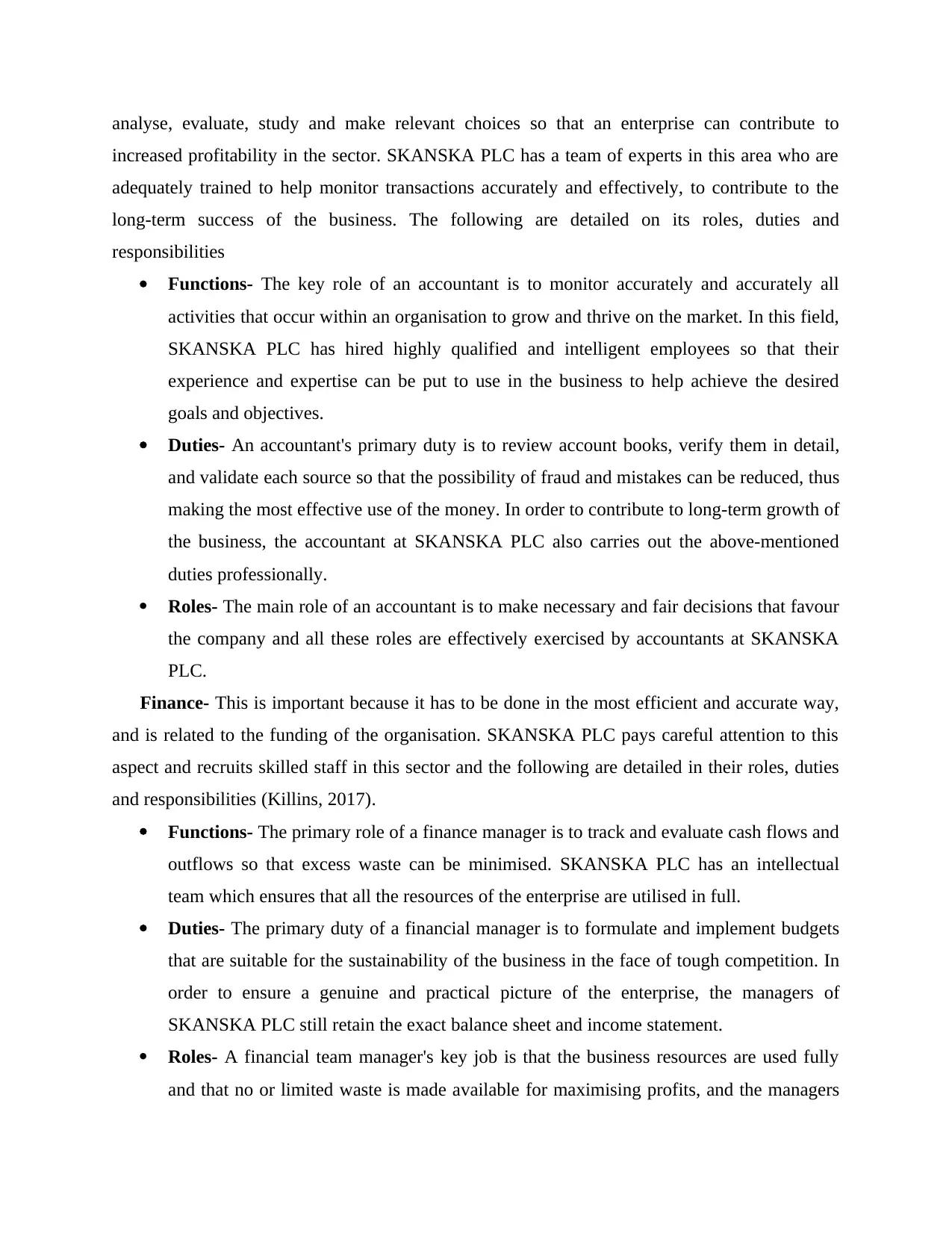
analyse, evaluate, study and make relevant choices so that an enterprise can contribute to
increased profitability in the sector. SKANSKA PLC has a team of experts in this area who are
adequately trained to help monitor transactions accurately and effectively, to contribute to the
long-term success of the business. The following are detailed on its roles, duties and
responsibilities
Functions- The key role of an accountant is to monitor accurately and accurately all
activities that occur within an organisation to grow and thrive on the market. In this field,
SKANSKA PLC has hired highly qualified and intelligent employees so that their
experience and expertise can be put to use in the business to help achieve the desired
goals and objectives.
Duties- An accountant's primary duty is to review account books, verify them in detail,
and validate each source so that the possibility of fraud and mistakes can be reduced, thus
making the most effective use of the money. In order to contribute to long-term growth of
the business, the accountant at SKANSKA PLC also carries out the above-mentioned
duties professionally.
Roles- The main role of an accountant is to make necessary and fair decisions that favour
the company and all these roles are effectively exercised by accountants at SKANSKA
PLC.
Finance- This is important because it has to be done in the most efficient and accurate way,
and is related to the funding of the organisation. SKANSKA PLC pays careful attention to this
aspect and recruits skilled staff in this sector and the following are detailed in their roles, duties
and responsibilities (Killins, 2017).
Functions- The primary role of a finance manager is to track and evaluate cash flows and
outflows so that excess waste can be minimised. SKANSKA PLC has an intellectual
team which ensures that all the resources of the enterprise are utilised in full.
Duties- The primary duty of a financial manager is to formulate and implement budgets
that are suitable for the sustainability of the business in the face of tough competition. In
order to ensure a genuine and practical picture of the enterprise, the managers of
SKANSKA PLC still retain the exact balance sheet and income statement.
Roles- A financial team manager's key job is that the business resources are used fully
and that no or limited waste is made available for maximising profits, and the managers
increased profitability in the sector. SKANSKA PLC has a team of experts in this area who are
adequately trained to help monitor transactions accurately and effectively, to contribute to the
long-term success of the business. The following are detailed on its roles, duties and
responsibilities
Functions- The key role of an accountant is to monitor accurately and accurately all
activities that occur within an organisation to grow and thrive on the market. In this field,
SKANSKA PLC has hired highly qualified and intelligent employees so that their
experience and expertise can be put to use in the business to help achieve the desired
goals and objectives.
Duties- An accountant's primary duty is to review account books, verify them in detail,
and validate each source so that the possibility of fraud and mistakes can be reduced, thus
making the most effective use of the money. In order to contribute to long-term growth of
the business, the accountant at SKANSKA PLC also carries out the above-mentioned
duties professionally.
Roles- The main role of an accountant is to make necessary and fair decisions that favour
the company and all these roles are effectively exercised by accountants at SKANSKA
PLC.
Finance- This is important because it has to be done in the most efficient and accurate way,
and is related to the funding of the organisation. SKANSKA PLC pays careful attention to this
aspect and recruits skilled staff in this sector and the following are detailed in their roles, duties
and responsibilities (Killins, 2017).
Functions- The primary role of a finance manager is to track and evaluate cash flows and
outflows so that excess waste can be minimised. SKANSKA PLC has an intellectual
team which ensures that all the resources of the enterprise are utilised in full.
Duties- The primary duty of a financial manager is to formulate and implement budgets
that are suitable for the sustainability of the business in the face of tough competition. In
order to ensure a genuine and practical picture of the enterprise, the managers of
SKANSKA PLC still retain the exact balance sheet and income statement.
Roles- A financial team manager's key job is that the business resources are used fully
and that no or limited waste is made available for maximising profits, and the managers
Paraphrase This Document
Need a fresh take? Get an instant paraphrase of this document with our AI Paraphraser
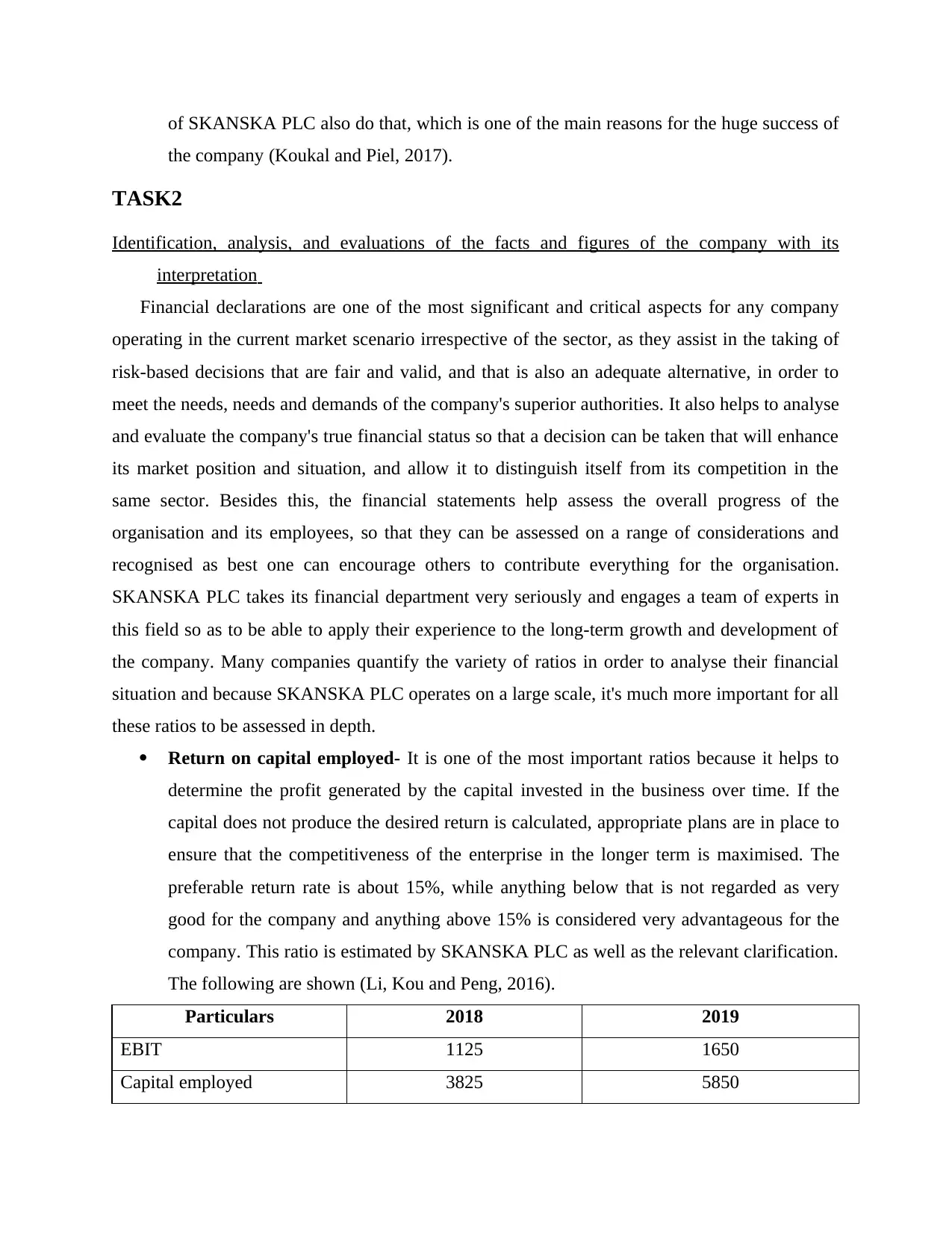
of SKANSKA PLC also do that, which is one of the main reasons for the huge success of
the company (Koukal and Piel, 2017).
TASK2
Identification, analysis, and evaluations of the facts and figures of the company with its
interpretation
Financial declarations are one of the most significant and critical aspects for any company
operating in the current market scenario irrespective of the sector, as they assist in the taking of
risk-based decisions that are fair and valid, and that is also an adequate alternative, in order to
meet the needs, needs and demands of the company's superior authorities. It also helps to analyse
and evaluate the company's true financial status so that a decision can be taken that will enhance
its market position and situation, and allow it to distinguish itself from its competition in the
same sector. Besides this, the financial statements help assess the overall progress of the
organisation and its employees, so that they can be assessed on a range of considerations and
recognised as best one can encourage others to contribute everything for the organisation.
SKANSKA PLC takes its financial department very seriously and engages a team of experts in
this field so as to be able to apply their experience to the long-term growth and development of
the company. Many companies quantify the variety of ratios in order to analyse their financial
situation and because SKANSKA PLC operates on a large scale, it's much more important for all
these ratios to be assessed in depth.
Return on capital employed- It is one of the most important ratios because it helps to
determine the profit generated by the capital invested in the business over time. If the
capital does not produce the desired return is calculated, appropriate plans are in place to
ensure that the competitiveness of the enterprise in the longer term is maximised. The
preferable return rate is about 15%, while anything below that is not regarded as very
good for the company and anything above 15% is considered very advantageous for the
company. This ratio is estimated by SKANSKA PLC as well as the relevant clarification.
The following are shown (Li, Kou and Peng, 2016).
Particulars 2018 2019
EBIT 1125 1650
Capital employed 3825 5850
the company (Koukal and Piel, 2017).
TASK2
Identification, analysis, and evaluations of the facts and figures of the company with its
interpretation
Financial declarations are one of the most significant and critical aspects for any company
operating in the current market scenario irrespective of the sector, as they assist in the taking of
risk-based decisions that are fair and valid, and that is also an adequate alternative, in order to
meet the needs, needs and demands of the company's superior authorities. It also helps to analyse
and evaluate the company's true financial status so that a decision can be taken that will enhance
its market position and situation, and allow it to distinguish itself from its competition in the
same sector. Besides this, the financial statements help assess the overall progress of the
organisation and its employees, so that they can be assessed on a range of considerations and
recognised as best one can encourage others to contribute everything for the organisation.
SKANSKA PLC takes its financial department very seriously and engages a team of experts in
this field so as to be able to apply their experience to the long-term growth and development of
the company. Many companies quantify the variety of ratios in order to analyse their financial
situation and because SKANSKA PLC operates on a large scale, it's much more important for all
these ratios to be assessed in depth.
Return on capital employed- It is one of the most important ratios because it helps to
determine the profit generated by the capital invested in the business over time. If the
capital does not produce the desired return is calculated, appropriate plans are in place to
ensure that the competitiveness of the enterprise in the longer term is maximised. The
preferable return rate is about 15%, while anything below that is not regarded as very
good for the company and anything above 15% is considered very advantageous for the
company. This ratio is estimated by SKANSKA PLC as well as the relevant clarification.
The following are shown (Li, Kou and Peng, 2016).
Particulars 2018 2019
EBIT 1125 1650
Capital employed 3825 5850
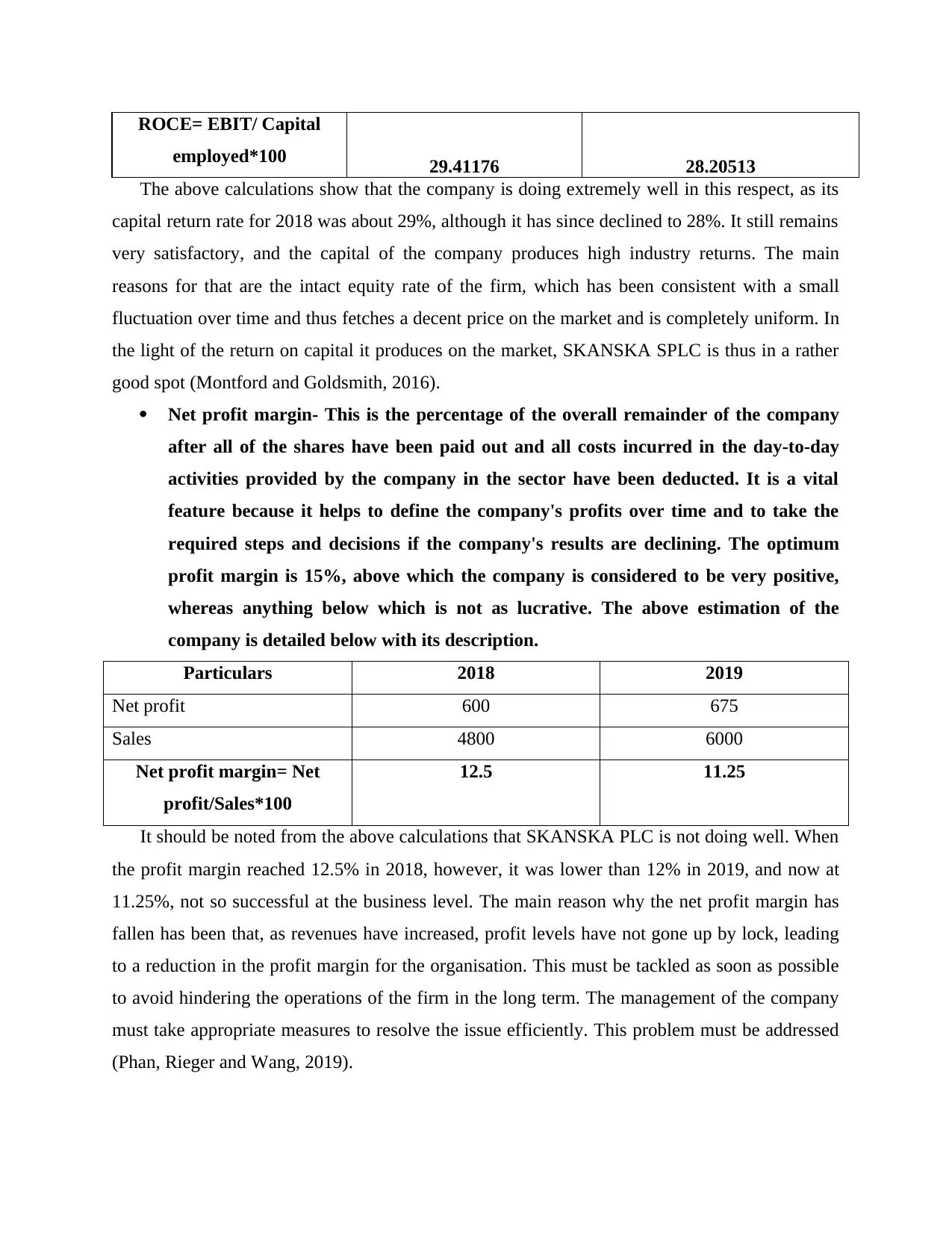
ROCE= EBIT/ Capital
employed*100 29.41176 28.20513
The above calculations show that the company is doing extremely well in this respect, as its
capital return rate for 2018 was about 29%, although it has since declined to 28%. It still remains
very satisfactory, and the capital of the company produces high industry returns. The main
reasons for that are the intact equity rate of the firm, which has been consistent with a small
fluctuation over time and thus fetches a decent price on the market and is completely uniform. In
the light of the return on capital it produces on the market, SKANSKA SPLC is thus in a rather
good spot (Montford and Goldsmith, 2016).
Net profit margin- This is the percentage of the overall remainder of the company
after all of the shares have been paid out and all costs incurred in the day-to-day
activities provided by the company in the sector have been deducted. It is a vital
feature because it helps to define the company's profits over time and to take the
required steps and decisions if the company's results are declining. The optimum
profit margin is 15%, above which the company is considered to be very positive,
whereas anything below which is not as lucrative. The above estimation of the
company is detailed below with its description.
Particulars 2018 2019
Net profit 600 675
Sales 4800 6000
Net profit margin= Net
profit/Sales*100
12.5 11.25
It should be noted from the above calculations that SKANSKA PLC is not doing well. When
the profit margin reached 12.5% in 2018, however, it was lower than 12% in 2019, and now at
11.25%, not so successful at the business level. The main reason why the net profit margin has
fallen has been that, as revenues have increased, profit levels have not gone up by lock, leading
to a reduction in the profit margin for the organisation. This must be tackled as soon as possible
to avoid hindering the operations of the firm in the long term. The management of the company
must take appropriate measures to resolve the issue efficiently. This problem must be addressed
(Phan, Rieger and Wang, 2019).
employed*100 29.41176 28.20513
The above calculations show that the company is doing extremely well in this respect, as its
capital return rate for 2018 was about 29%, although it has since declined to 28%. It still remains
very satisfactory, and the capital of the company produces high industry returns. The main
reasons for that are the intact equity rate of the firm, which has been consistent with a small
fluctuation over time and thus fetches a decent price on the market and is completely uniform. In
the light of the return on capital it produces on the market, SKANSKA SPLC is thus in a rather
good spot (Montford and Goldsmith, 2016).
Net profit margin- This is the percentage of the overall remainder of the company
after all of the shares have been paid out and all costs incurred in the day-to-day
activities provided by the company in the sector have been deducted. It is a vital
feature because it helps to define the company's profits over time and to take the
required steps and decisions if the company's results are declining. The optimum
profit margin is 15%, above which the company is considered to be very positive,
whereas anything below which is not as lucrative. The above estimation of the
company is detailed below with its description.
Particulars 2018 2019
Net profit 600 675
Sales 4800 6000
Net profit margin= Net
profit/Sales*100
12.5 11.25
It should be noted from the above calculations that SKANSKA PLC is not doing well. When
the profit margin reached 12.5% in 2018, however, it was lower than 12% in 2019, and now at
11.25%, not so successful at the business level. The main reason why the net profit margin has
fallen has been that, as revenues have increased, profit levels have not gone up by lock, leading
to a reduction in the profit margin for the organisation. This must be tackled as soon as possible
to avoid hindering the operations of the firm in the long term. The management of the company
must take appropriate measures to resolve the issue efficiently. This problem must be addressed
(Phan, Rieger and Wang, 2019).
⊘ This is a preview!⊘
Do you want full access?
Subscribe today to unlock all pages.

Trusted by 1+ million students worldwide
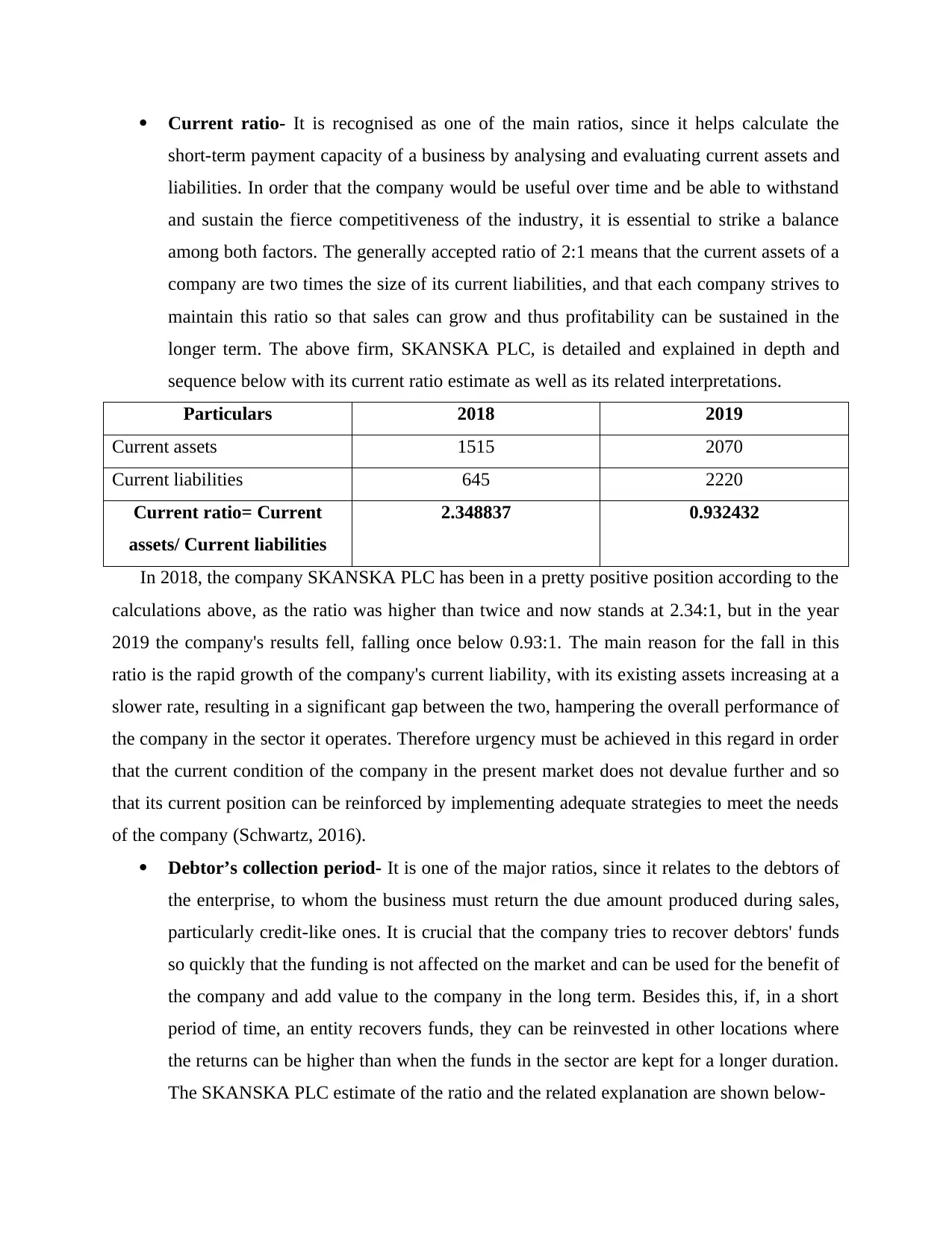
Current ratio- It is recognised as one of the main ratios, since it helps calculate the
short-term payment capacity of a business by analysing and evaluating current assets and
liabilities. In order that the company would be useful over time and be able to withstand
and sustain the fierce competitiveness of the industry, it is essential to strike a balance
among both factors. The generally accepted ratio of 2:1 means that the current assets of a
company are two times the size of its current liabilities, and that each company strives to
maintain this ratio so that sales can grow and thus profitability can be sustained in the
longer term. The above firm, SKANSKA PLC, is detailed and explained in depth and
sequence below with its current ratio estimate as well as its related interpretations.
Particulars 2018 2019
Current assets 1515 2070
Current liabilities 645 2220
Current ratio= Current
assets/ Current liabilities
2.348837 0.932432
In 2018, the company SKANSKA PLC has been in a pretty positive position according to the
calculations above, as the ratio was higher than twice and now stands at 2.34:1, but in the year
2019 the company's results fell, falling once below 0.93:1. The main reason for the fall in this
ratio is the rapid growth of the company's current liability, with its existing assets increasing at a
slower rate, resulting in a significant gap between the two, hampering the overall performance of
the company in the sector it operates. Therefore urgency must be achieved in this regard in order
that the current condition of the company in the present market does not devalue further and so
that its current position can be reinforced by implementing adequate strategies to meet the needs
of the company (Schwartz, 2016).
Debtor’s collection period- It is one of the major ratios, since it relates to the debtors of
the enterprise, to whom the business must return the due amount produced during sales,
particularly credit-like ones. It is crucial that the company tries to recover debtors' funds
so quickly that the funding is not affected on the market and can be used for the benefit of
the company and add value to the company in the long term. Besides this, if, in a short
period of time, an entity recovers funds, they can be reinvested in other locations where
the returns can be higher than when the funds in the sector are kept for a longer duration.
The SKANSKA PLC estimate of the ratio and the related explanation are shown below-
short-term payment capacity of a business by analysing and evaluating current assets and
liabilities. In order that the company would be useful over time and be able to withstand
and sustain the fierce competitiveness of the industry, it is essential to strike a balance
among both factors. The generally accepted ratio of 2:1 means that the current assets of a
company are two times the size of its current liabilities, and that each company strives to
maintain this ratio so that sales can grow and thus profitability can be sustained in the
longer term. The above firm, SKANSKA PLC, is detailed and explained in depth and
sequence below with its current ratio estimate as well as its related interpretations.
Particulars 2018 2019
Current assets 1515 2070
Current liabilities 645 2220
Current ratio= Current
assets/ Current liabilities
2.348837 0.932432
In 2018, the company SKANSKA PLC has been in a pretty positive position according to the
calculations above, as the ratio was higher than twice and now stands at 2.34:1, but in the year
2019 the company's results fell, falling once below 0.93:1. The main reason for the fall in this
ratio is the rapid growth of the company's current liability, with its existing assets increasing at a
slower rate, resulting in a significant gap between the two, hampering the overall performance of
the company in the sector it operates. Therefore urgency must be achieved in this regard in order
that the current condition of the company in the present market does not devalue further and so
that its current position can be reinforced by implementing adequate strategies to meet the needs
of the company (Schwartz, 2016).
Debtor’s collection period- It is one of the major ratios, since it relates to the debtors of
the enterprise, to whom the business must return the due amount produced during sales,
particularly credit-like ones. It is crucial that the company tries to recover debtors' funds
so quickly that the funding is not affected on the market and can be used for the benefit of
the company and add value to the company in the long term. Besides this, if, in a short
period of time, an entity recovers funds, they can be reinvested in other locations where
the returns can be higher than when the funds in the sector are kept for a longer duration.
The SKANSKA PLC estimate of the ratio and the related explanation are shown below-
Paraphrase This Document
Need a fresh take? Get an instant paraphrase of this document with our AI Paraphraser
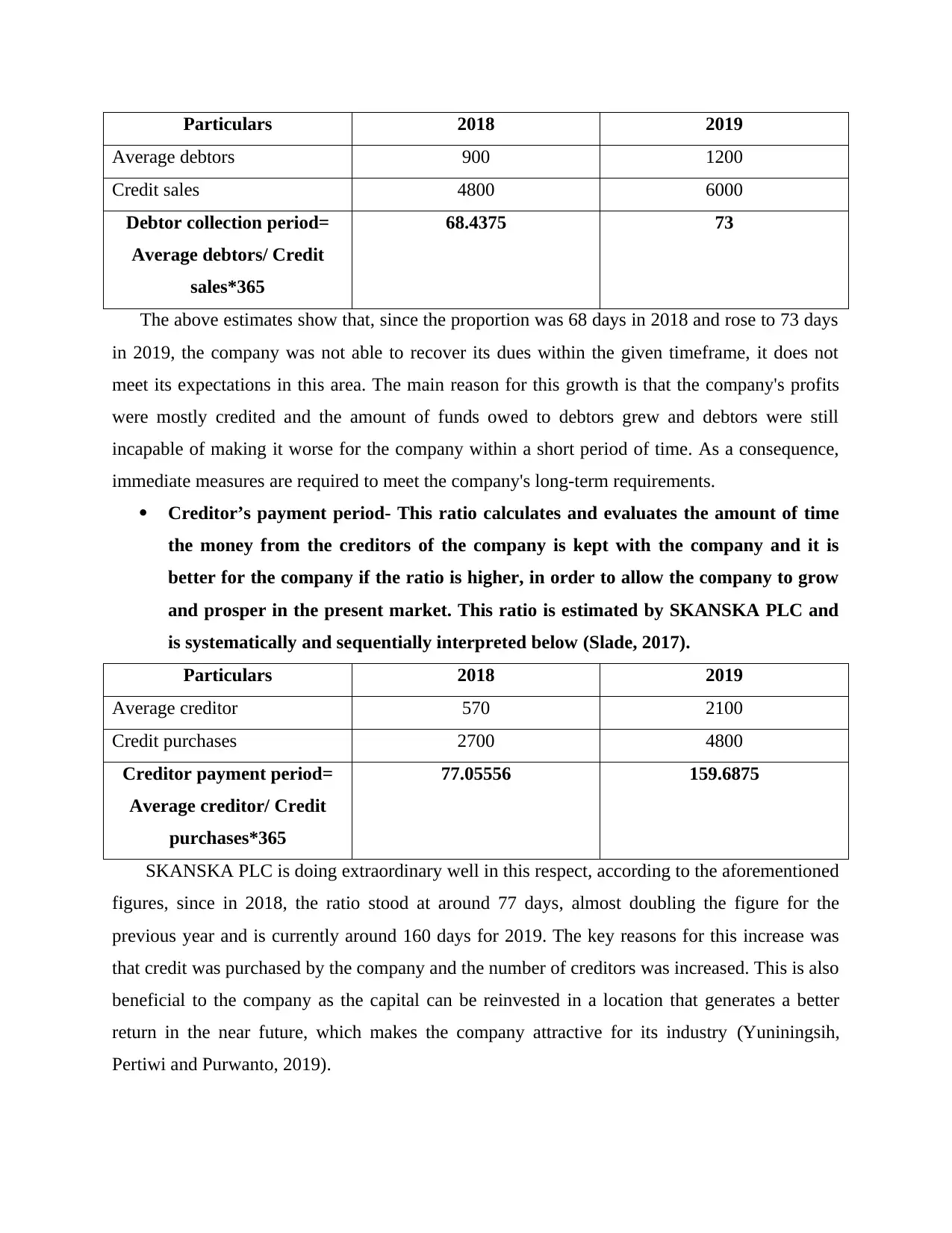
Particulars 2018 2019
Average debtors 900 1200
Credit sales 4800 6000
Debtor collection period=
Average debtors/ Credit
sales*365
68.4375 73
The above estimates show that, since the proportion was 68 days in 2018 and rose to 73 days
in 2019, the company was not able to recover its dues within the given timeframe, it does not
meet its expectations in this area. The main reason for this growth is that the company's profits
were mostly credited and the amount of funds owed to debtors grew and debtors were still
incapable of making it worse for the company within a short period of time. As a consequence,
immediate measures are required to meet the company's long-term requirements.
Creditor’s payment period- This ratio calculates and evaluates the amount of time
the money from the creditors of the company is kept with the company and it is
better for the company if the ratio is higher, in order to allow the company to grow
and prosper in the present market. This ratio is estimated by SKANSKA PLC and
is systematically and sequentially interpreted below (Slade, 2017).
Particulars 2018 2019
Average creditor 570 2100
Credit purchases 2700 4800
Creditor payment period=
Average creditor/ Credit
purchases*365
77.05556 159.6875
SKANSKA PLC is doing extraordinary well in this respect, according to the aforementioned
figures, since in 2018, the ratio stood at around 77 days, almost doubling the figure for the
previous year and is currently around 160 days for 2019. The key reasons for this increase was
that credit was purchased by the company and the number of creditors was increased. This is also
beneficial to the company as the capital can be reinvested in a location that generates a better
return in the near future, which makes the company attractive for its industry (Yuniningsih,
Pertiwi and Purwanto, 2019).
Average debtors 900 1200
Credit sales 4800 6000
Debtor collection period=
Average debtors/ Credit
sales*365
68.4375 73
The above estimates show that, since the proportion was 68 days in 2018 and rose to 73 days
in 2019, the company was not able to recover its dues within the given timeframe, it does not
meet its expectations in this area. The main reason for this growth is that the company's profits
were mostly credited and the amount of funds owed to debtors grew and debtors were still
incapable of making it worse for the company within a short period of time. As a consequence,
immediate measures are required to meet the company's long-term requirements.
Creditor’s payment period- This ratio calculates and evaluates the amount of time
the money from the creditors of the company is kept with the company and it is
better for the company if the ratio is higher, in order to allow the company to grow
and prosper in the present market. This ratio is estimated by SKANSKA PLC and
is systematically and sequentially interpreted below (Slade, 2017).
Particulars 2018 2019
Average creditor 570 2100
Credit purchases 2700 4800
Creditor payment period=
Average creditor/ Credit
purchases*365
77.05556 159.6875
SKANSKA PLC is doing extraordinary well in this respect, according to the aforementioned
figures, since in 2018, the ratio stood at around 77 days, almost doubling the figure for the
previous year and is currently around 160 days for 2019. The key reasons for this increase was
that credit was purchased by the company and the number of creditors was increased. This is also
beneficial to the company as the capital can be reinvested in a location that generates a better
return in the near future, which makes the company attractive for its industry (Yuniningsih,
Pertiwi and Purwanto, 2019).
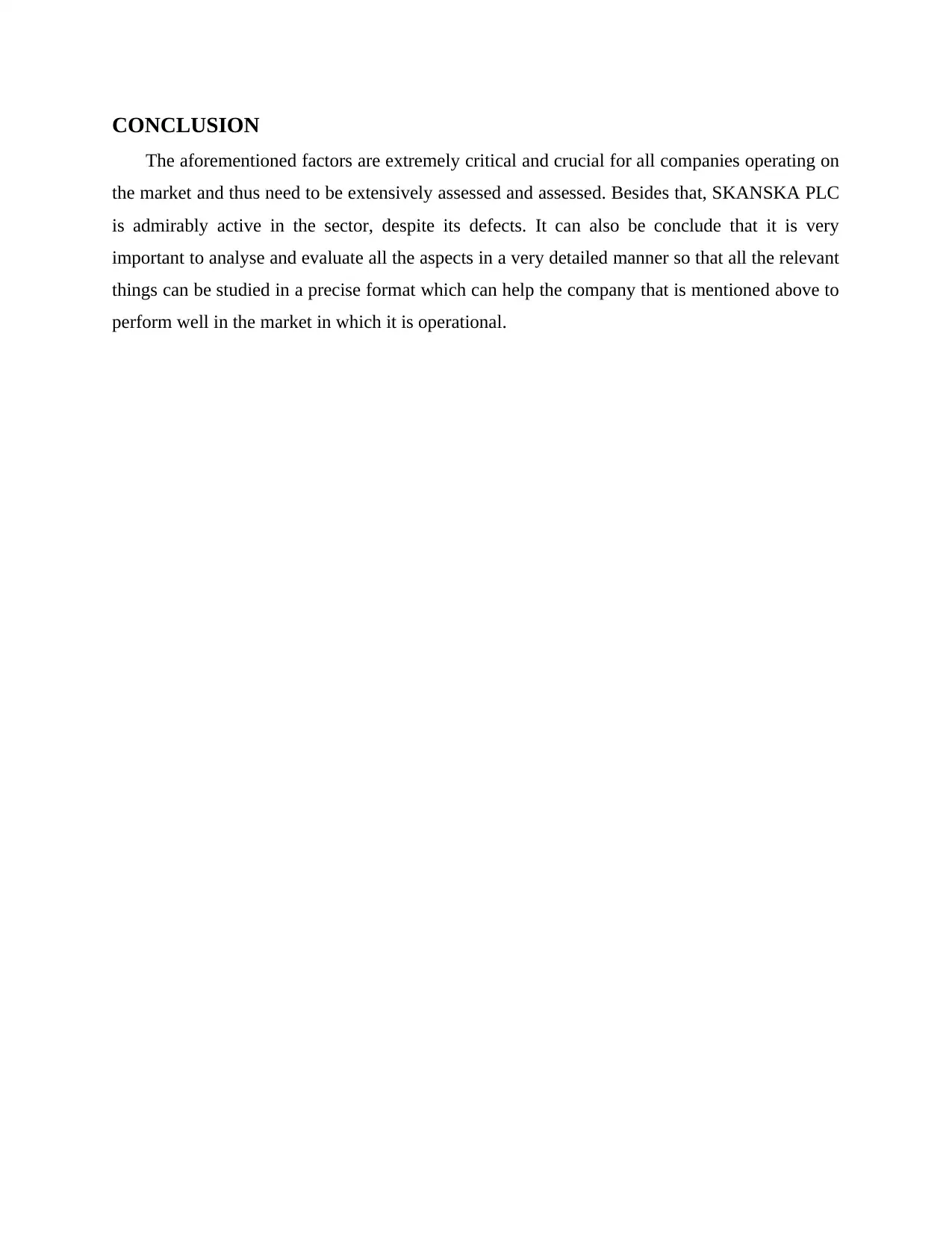
CONCLUSION
The aforementioned factors are extremely critical and crucial for all companies operating on
the market and thus need to be extensively assessed and assessed. Besides that, SKANSKA PLC
is admirably active in the sector, despite its defects. It can also be conclude that it is very
important to analyse and evaluate all the aspects in a very detailed manner so that all the relevant
things can be studied in a precise format which can help the company that is mentioned above to
perform well in the market in which it is operational.
The aforementioned factors are extremely critical and crucial for all companies operating on
the market and thus need to be extensively assessed and assessed. Besides that, SKANSKA PLC
is admirably active in the sector, despite its defects. It can also be conclude that it is very
important to analyse and evaluate all the aspects in a very detailed manner so that all the relevant
things can be studied in a precise format which can help the company that is mentioned above to
perform well in the market in which it is operational.
⊘ This is a preview!⊘
Do you want full access?
Subscribe today to unlock all pages.

Trusted by 1+ million students worldwide
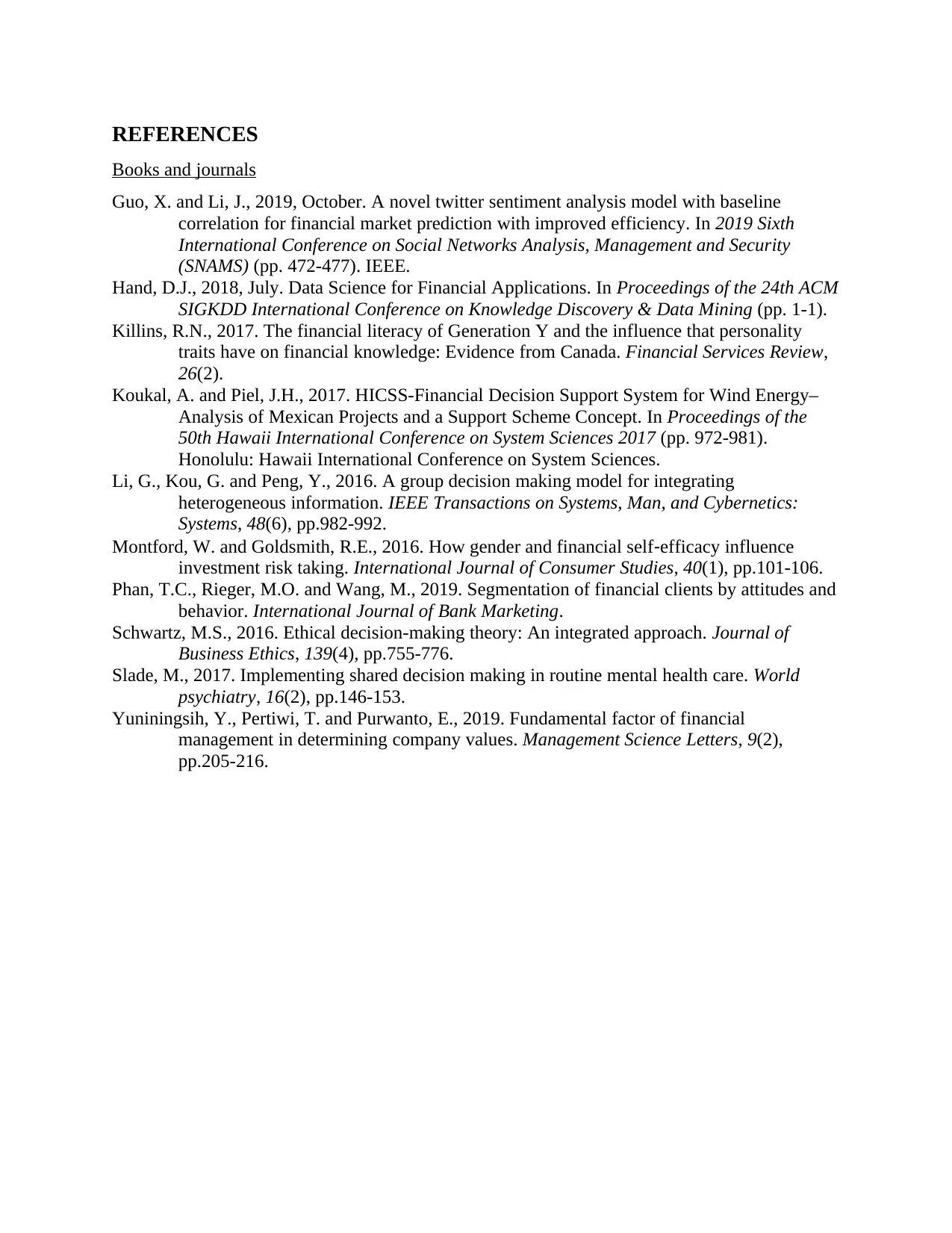
REFERENCES
Books and journals
Guo, X. and Li, J., 2019, October. A novel twitter sentiment analysis model with baseline
correlation for financial market prediction with improved efficiency. In 2019 Sixth
International Conference on Social Networks Analysis, Management and Security
(SNAMS) (pp. 472-477). IEEE.
Hand, D.J., 2018, July. Data Science for Financial Applications. In Proceedings of the 24th ACM
SIGKDD International Conference on Knowledge Discovery & Data Mining (pp. 1-1).
Killins, R.N., 2017. The financial literacy of Generation Y and the influence that personality
traits have on financial knowledge: Evidence from Canada. Financial Services Review,
26(2).
Koukal, A. and Piel, J.H., 2017. HICSS-Financial Decision Support System for Wind Energy–
Analysis of Mexican Projects and a Support Scheme Concept. In Proceedings of the
50th Hawaii International Conference on System Sciences 2017 (pp. 972-981).
Honolulu: Hawaii International Conference on System Sciences.
Li, G., Kou, G. and Peng, Y., 2016. A group decision making model for integrating
heterogeneous information. IEEE Transactions on Systems, Man, and Cybernetics:
Systems, 48(6), pp.982-992.
Montford, W. and Goldsmith, R.E., 2016. How gender and financial self‐efficacy influence
investment risk taking. International Journal of Consumer Studies, 40(1), pp.101-106.
Phan, T.C., Rieger, M.O. and Wang, M., 2019. Segmentation of financial clients by attitudes and
behavior. International Journal of Bank Marketing.
Schwartz, M.S., 2016. Ethical decision-making theory: An integrated approach. Journal of
Business Ethics, 139(4), pp.755-776.
Slade, M., 2017. Implementing shared decision making in routine mental health care. World
psychiatry, 16(2), pp.146-153.
Yuniningsih, Y., Pertiwi, T. and Purwanto, E., 2019. Fundamental factor of financial
management in determining company values. Management Science Letters, 9(2),
pp.205-216.
Books and journals
Guo, X. and Li, J., 2019, October. A novel twitter sentiment analysis model with baseline
correlation for financial market prediction with improved efficiency. In 2019 Sixth
International Conference on Social Networks Analysis, Management and Security
(SNAMS) (pp. 472-477). IEEE.
Hand, D.J., 2018, July. Data Science for Financial Applications. In Proceedings of the 24th ACM
SIGKDD International Conference on Knowledge Discovery & Data Mining (pp. 1-1).
Killins, R.N., 2017. The financial literacy of Generation Y and the influence that personality
traits have on financial knowledge: Evidence from Canada. Financial Services Review,
26(2).
Koukal, A. and Piel, J.H., 2017. HICSS-Financial Decision Support System for Wind Energy–
Analysis of Mexican Projects and a Support Scheme Concept. In Proceedings of the
50th Hawaii International Conference on System Sciences 2017 (pp. 972-981).
Honolulu: Hawaii International Conference on System Sciences.
Li, G., Kou, G. and Peng, Y., 2016. A group decision making model for integrating
heterogeneous information. IEEE Transactions on Systems, Man, and Cybernetics:
Systems, 48(6), pp.982-992.
Montford, W. and Goldsmith, R.E., 2016. How gender and financial self‐efficacy influence
investment risk taking. International Journal of Consumer Studies, 40(1), pp.101-106.
Phan, T.C., Rieger, M.O. and Wang, M., 2019. Segmentation of financial clients by attitudes and
behavior. International Journal of Bank Marketing.
Schwartz, M.S., 2016. Ethical decision-making theory: An integrated approach. Journal of
Business Ethics, 139(4), pp.755-776.
Slade, M., 2017. Implementing shared decision making in routine mental health care. World
psychiatry, 16(2), pp.146-153.
Yuniningsih, Y., Pertiwi, T. and Purwanto, E., 2019. Fundamental factor of financial
management in determining company values. Management Science Letters, 9(2),
pp.205-216.
1 out of 10
Related Documents
Your All-in-One AI-Powered Toolkit for Academic Success.
+13062052269
info@desklib.com
Available 24*7 on WhatsApp / Email
![[object Object]](/_next/static/media/star-bottom.7253800d.svg)
Unlock your academic potential
Copyright © 2020–2025 A2Z Services. All Rights Reserved. Developed and managed by ZUCOL.





